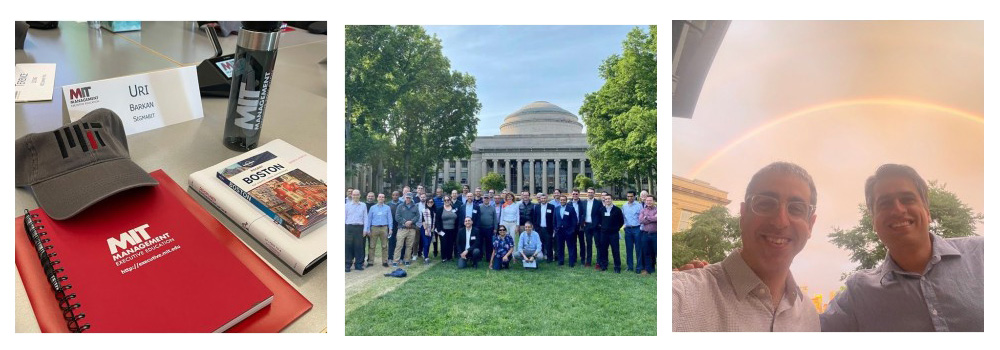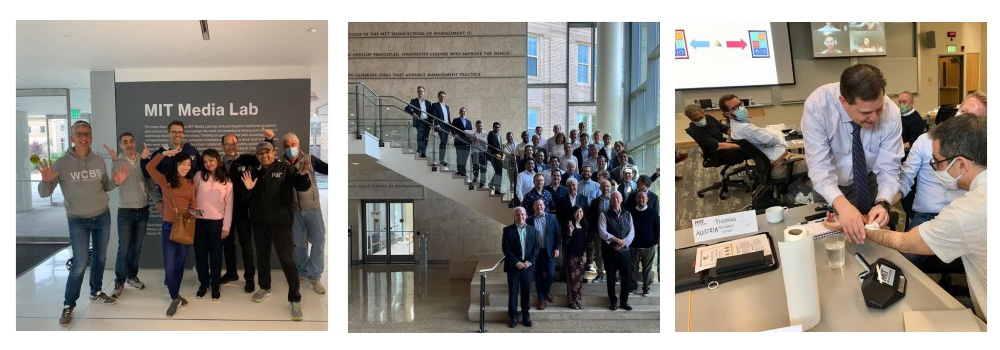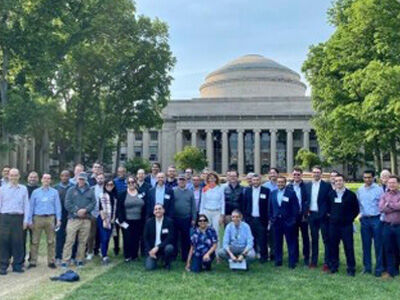“Ten minutes into his lecture about disciplined entrepreneurship, [MIT Sloan Professor] Bill Aulet asked us: ‘You know what MBA stands for, right? [dramatic pause] Management By Arrogance.’ This was when I knew I got to the right place...”
Uri Barkan is Founder and GM at Sigmabit and a graduate of the May 2022 Advanced Management Program (AMP) at MIT Sloan Executive Education – our month-long senior executive program designed for a diverse group of experienced leaders seeking transformative learning among global peers. But what exactly does that all mean? Now with a couple of months following his completion of the program, Barkan reflects on his AMP experience with the aim to arm prospective attendees with helpful behind-the-scenes information and encourage them to take the leap. (You can read his full personal account here).
Why AMP at MIT?
As Barkan researched various executive programs, AMP became the clear choice for a variety of reasons. First, there’s the intimate cohort size, which is limited to 42 participants. “The small class size allows two things: a better lecturer-per-student ratio, reinforced by the fact that lecturers make themselves available for the students after class and the participants can develop stronger relationships. In a group of 30 to 40, it is totally feasible to get to know all the cohort members quite well.”
Barkan, a physicist by training, was also drawn to the scientific reputation of MIT. “Studying at MIT has always been one of my aspirations. Generally speaking, the labs in the campus are quite accessible to the students on site, AMP participants included. For geeks with passion for science, MIT is Disneyland.”
Lastly, diversity was another priority. “Our class was highly diverse. I had a once-in-a-lifetime chance to discuss with a peer what would happen to the GDP of Colombia had the drugs' cartel suddenly ceased to exist; learned about how the legislation in Southeast Asia influences the chances of female entrepreneurs; listened to an American-Indian executive share his life story - including the first job he took as an immigrant when he came to the US 20-something years ago with $200, and how it has served him 20-something years later as a VP in a large medical devices corporation… Just a few examples out of many which highlight how your group can enrich your experience.”

Preparing for the five weeks away from work (and home)…
One of the more potentially daunting factors of AMP is the idea of being away from your professional (and personal) commitments for five weeks. Yes, you will need support – from your organization, your colleagues, and your family. Communication and planning are key per Barkan. “First, try to advance every important event or commitment, critical meetings with customers or board gatherings prior to your leaving. This will give you the confidence that things will go smoothly... Furthermore, it’s a good exercise for your team… take into account that decisions will be made without you. Communicate it to your team in advance, tell them what you expect, let them know that you trust them, give them a few last tips, and get to the airport. Letting go is an important part of the change you will experience. It’s a rare opportunity to be with yourself and have the attentiveness to think where you and your organization are heading without background noise - don’t take it lightly.”
Prior to the start of the program, participants begin to receive various reading materials – such as articles or chapters from books – to lay the foundation for future learning. Barkan stresses that it’s important to come to class prepared as you’ll frequently be working in teams and you don’t want to impact the learning experience of your classmates.
What to expect during AMP
Barkan compares the curriculum to a tasting menu. “You are going to be exposed to many subjects in a very short time. If you have some background on the subject of the lecture, you get to hear a world-class expert’s angle on it. If you don’t have a background, but you find the dish interesting, you will get the ingredients and recipe needed to go into the kitchen and keep exploring. Business studies as a culinary journey!”
“The purpose of the simulations and the coaching is that you don’t wait until you get back home to start implementing what you learn in class. If things don’t sit right, it’s better to clarify the issues while you are there.”
MIT’s teaching philosophy Mens et Manus (Mind and Hand), which promotes the importance of practical application of education, or learning by doing, really resonated with Barkan as well. Participants are not simply reading case studies and listening to lectures – they are given exercises or experiment with simulations to apply what they’ve learned. “This approach allows internalization of the curriculum, transforming it from theoretical notions to practical tools, while engaging the students and keeping them sharp.”
While it may have been a while since you’ve been in an academic setting, Barkan reassures future participants that the workload is manageable and rarely are you staying up until the early morning. You’ll have a full day of classes and typically 1-3 hours of self-paced learning afterwards. Lastly, you’ll also have a variety of personal coaching sessions with a faculty member assigned to you based on your particular professional dilemmas and goals. “The purpose of the simulations and the coaching is that you don’t wait until you get back home to start implementing what you learn in class. If things don’t sit right, it’s better to clarify the issues while you are there.”
However, if you manage your time properly, there is plenty of free time to be able to explore and socialize. Barkan enthuses “Boston is one of the greatest cities for tourists. Go see the Celtics or the Red Sox, visit the famous parks and museums, enjoy live concerts, or just go out for a long run or a bike tour. You don’t have to choose and can also squeeze all of the above into your stay. It’s an important part of building your resilience before your return home to your family and colleagues.”

Curriculum
Week 1: Orientation
Your first week begins with an orientation to MIT – addressing basic administrative logistics and receiving an in-depth tour of the campus. In the classroom, the curriculum focuses on leadership – specifically on change management and how leaders can promote organizational change despite possible opposition.
The purpose of this week is three-fold:
- Connect AMP participants more deeply as a learning community and integrate them into the community of MIT and its surrounding environment
- Provide context and frameworks that will be useful touchstones throughout the AMP experience
- Offer new ways of thinking about themselves as leaders and change agents
Week 2: Strategy & Systems
The second week enables participants to integrate crisis management, system dynamics, and organizational skills into their thinking and projects. Topics covered include system dynamics, design thinking, causal loops, and macro-economics. At this point, the class is divided into teams of 5-6 individuals, with each team given the same data about a struggling fictional company for which they will need to develop a new business strategy. As each week passes, your team is given new data based on the strategies you’ve decided to implement via a software simulation program. (And true to real life, that simulation may throw you a couple unexpected setbacks with which to contend).
Barkan confides “You may feel like peace, love and brotherhood are the dominant values in class until you get to the first day of the simulation,” Barkan confides. “Putting together 40+ executives and letting them compete in a lab environment can tell you a lot about what works and what doesn’t work in the capitalist hyper-competitive system.”
Week 3: Innovation & Entrepreneurship
The week begins with integrating sessions on design thinking, entrepreneurship and organizing for speed and innovation. The final two days are devoted to connecting with AMP alumni, refreshing everyone’s understanding about a particular issue, market, or geography, and developing plans for sustaining the AMP learning community. At this popular event, Exec Ed alumni from over the years are invited back to connect with the MIT Sloan community, and to catch up with faculty and each other. It is a time of continuous learning, connection, and community.
Week 4: Digitalization &Technology
The purpose of the fourth week enables participants to manage more adroitly in a globalized and digital economic environment. By the end of the week, participants will be able to analyze the market and non-market forces that affect corporate outcomes, and evaluate the strategic implications of digital disruption and create a future-proofed digital business model. You’ll review how topics such as quantum computing, analytics, and sustainability are going to impact your business.
Week 5: Big Ideas in the Future
This final week is a flurry of activity. Classroom lessons on KPIs and asking the right questions are enhanced by various lab tours and discussions with MIT researches to better understand future business trends and relevant technologies. “This is a nice way to conclude the program, as it allows you to reflect about the journey you made…” The last two days are dedicated to the presentation of your team’s final project and your final farewell. Barkan admits “this is when things can get a bit emotional. Suddenly it hits you what an intense journey it was and how much you got attached to your cohort, despite the short time.”

Post-program takeaways
Barkan warns against expecting any magic fixes at the end of the program. “Business, like everything else in life, is complex. MIT believes in teaching you how to think, not what to think. For experienced managers, this approach is very helpful.” Instead of focusing on siloed disciplines, AMP provided broader lenses and approaches through which to view every aspect of one’s business – from customers to culture. “MIT’s AMP is not only about learning, it’s also about recharging, getting inspiration and opening yourself to the world.”
Ready to start exploring if AMP is right for you or someone you know? Learn more about the course here or contact the Program Team directly here.








